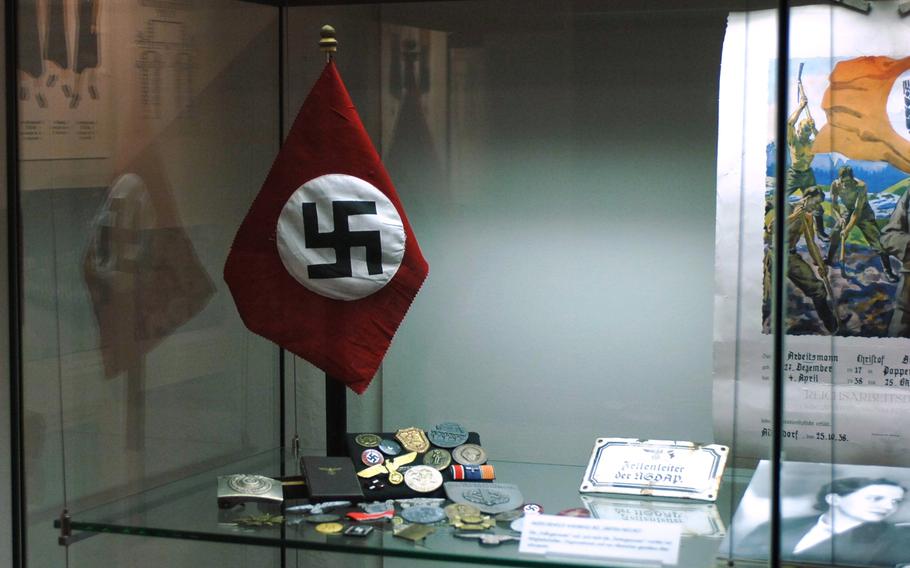
A Nazi flag and related paraphernalia are displayed at Stadtmuseum Schwabach in Schwabach, Germany. The museum, located near Nuremberg, features artifacts from World War II and the city's gold industry, among other items. Its main building was once home to the U.S. Army's O'Brien Barracks. (Gregory Broome/Stars and Stripes)
The stirring experience of visiting Stadtmuseum Schwabach in Schwabach, Germany, begins before you even enter its doors.
The museum, situated in a pleasant Bavarian town near Nuremberg, is, in fact, a hybrid of two distinct buildings. The structures represent the fascinating story the museum has to tell.
In the foreground sits a sleek, modern building of metal and glass surrounded by sculptures, fountains, meticulous landscaping and a terrace cafe. If it stood alone, one might mistake it for one of Germany’s acclaimed modern art galleries.
But it does not stand alone.
Behind the shining structure looms a bulky three-story behemoth. It is one of the many bland manila rectangles that populate Germany’s military bases, the austere buildings that housed German soldiers up to World War II and American servicemembers thereafter.
The symbolism is remarkably poignant. Here is a literal representation of Germany’s tragic, inescapable past encroaching on its hopeful present. And here is an average German town confronting and accepting that unchangeable history and constructing something new that represents optimism squarely in front of it.
Until recently, this converted military building — once a part of the U.S. Army’s O’Brien Barracks until its closure in 1992 — contained the whole of the museum. The new addition arrived in 2009, meant to draw attention to a sprawling collection concerning the city’s once-thriving gold industry.
The wing fulfills this mandate through a neat mix of static and interactive displays, all centered on a fascinating goldsmith’s workshop where visitors can witness the tools and techniques of the trade. English-language information is sparse, unfortunately, though most of the displays are self-explanatory.
Cheaper mass production in places such as China has severely undercut Schwabach’s once world-class gold industry, and so the display comes across as somber nostalgia for a more affluent age. This melancholy tone persists as visitors leave the new wing and step between the thick, sturdy walls of its historical neighbor.
The building’s staircases are emblazoned with words such as “competence,” “candor,” “will” and “initiative,” a concrete list of expected attributes for the many U.S. servicemembers who once planted their boots here. A commander’s office is preserved impeccably: a decorated green jacket rests over the back of a chair; shelves and walls bear posters of Uncle Sam and medals displayed in gray velvet cases; a legal pad and rotary phone represent the height of the desk’s available technology. Down the long hallway, past a sign reading “O’Brien Community Club,” is a bare-bones infirmary.
The building chronicles the events of the 20th century with unflinching and painstaking detail. The bold-faced name of Hitler dominates a chart of the Third Reich’s chain of command. A war poster depicts a skeleton atop a smoking jet, aiming a cannonball at a darkened city below. A sign reads Swing tanzen verboten, an oft-ignored order meant to prevent swing dancing and, by implication, other collaborative activities between American GIs and local women.
Just as the weight of these profound items begins to overwhelm the visitor, the museum offers respite. The remainder of the tour features lighter displays, highlighted by a sprawling layout of model cars and trains and the exotic specimens of the late German naturalist Carl Wenglein.
Back outside, the two contrasting buildings begin to make sense. The museum’s outer walls are odd and ill-fitting, a defiance of logic. In fact, they’re every bit as irrational as the messy history they contain within.
DIRECTIONS: Schwabach is south of Nuremberg, just off Autobahn 6, making it easily accessible from points west like Kaiserslautern, Heidelberg and Ansbach, or points east like Hohenfels and Grafenwöhr. Exit at Schwabach-Sud toward Schwabach, and follow highway B2 into the city. The museum is at the highway’s intersection with Ansbacher Strasse.
TIMES: Open year-round Wednesday through Sunday from 10 a.m. to 6 p.m.
COSTS: Entry to the museum is 5 euros for adults and 2.50 euros for ages up to 14 years old; a family ticket offers a nice discount at 10 euros for two adults and children. A number of guided tours and demonstrations are offered for a few extra euros apiece.
FOOD: The museum’s small bistro is limited to coffee and cold drinks, but there are two pizza places across the street and a slew of other options in the nearby city center.
INFORMATION: Visit schwabach.de for more about the museum and city.